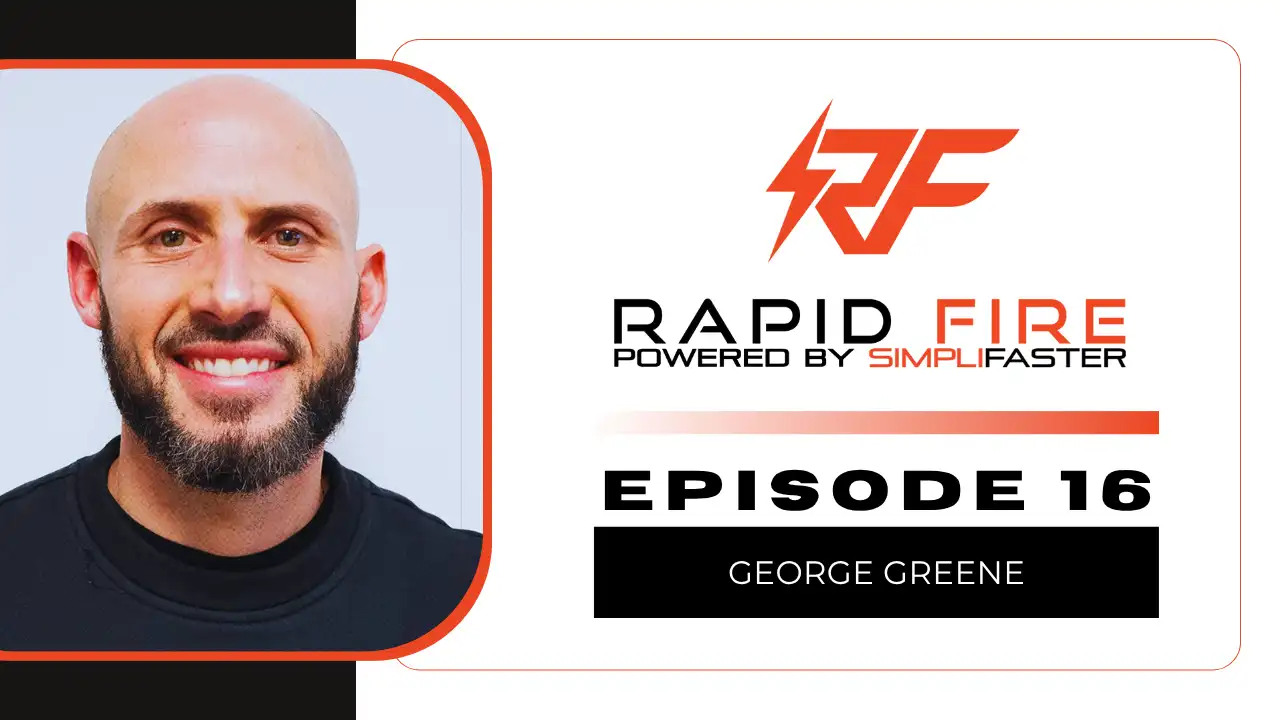[mashshare]
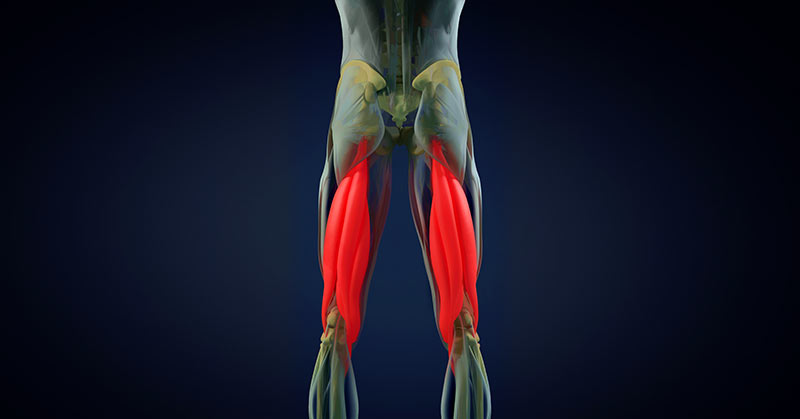
What Is the NordBord?
The NordBord Hamstring Testing System is a fast and easy way to objectively measure eccentric and isometric hamstring strength. The NordBord is the brainchild of Vald Performance, a company based in Brisbane, Australia. Vald Performance is unique, in that the company was born out of a research group at Queensland University of Technology (specifically, Dr. Anthony Shield and Dr. David Opar). I believe that the company’s academic- and research-based origins have helped make a product that is not only easy to use, but also comes with evidence-based guidelines that help drive best practices.
The NordBord Hardware
The NordBord itself measures about 3 feet long and 2 feet wide, most of which is a large padded area for the athlete to kneel on. The pad has “integrated knee position guides” that allow for easy readings of the athlete’s knee position and help with maintaining consistency in knee position from one test to the next (important when calculating torque). Once kneeling, the athlete slips their ankles into the padded ankle hooks and can then perform many different testing protocols (described in more detail later).
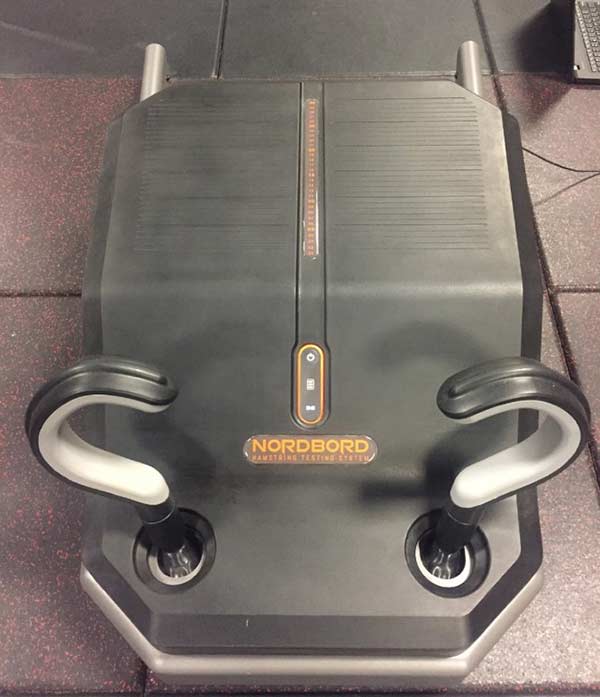
The ankle hooks themselves are connected to two force cells that measure the force (in Newtons) at which the ankle hooks are being pulled. The force measured by the two force cells is transmitted in real time to a host computer/tablet via a USB cable.
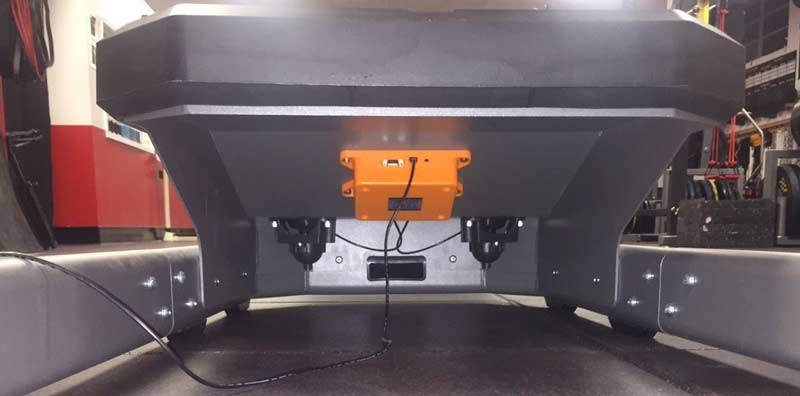
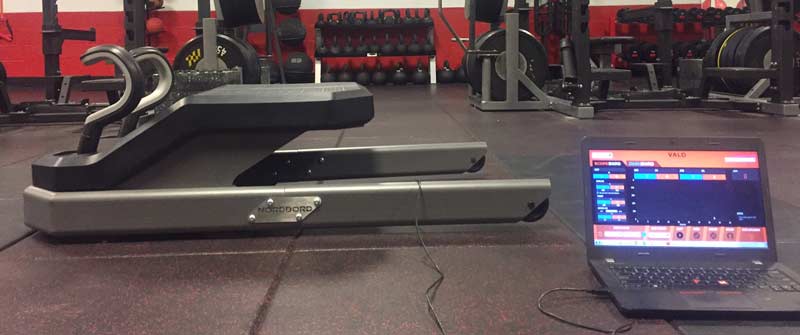
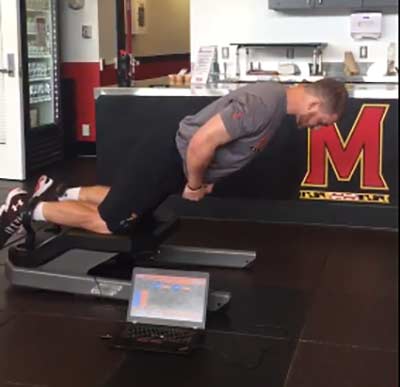
The NordBord itself is simple and very durable. After nine months of use and over 400 tests performed, it looks and operates just like it did the first time I used it. The two steel arms that make up the base of the NordBord have wheels, making it easy to move around the weight room or to different buildings. It can be easily deconstructed by loosening four screws to separate part of the base arms from the pad. The ankle hooks also can be unscrewed for easier travel. That being said, it definitely isn’t something that is convenient to travel with. It still would need its own bag and someone to carry that bag (but if you have the manpower, anything can be done).
The Scorebord and the Dashbord
The software provided with the NordBord has two separate platforms, the “Scorebord” and the “Dashbord.” The Scorebord gives the practitioner and the athlete real-time feedback on how much force is being recorded by the force cells for both the right and left limbs, as well as the percent discrepancy between the two. You can also view the previous test scores or the average of multiple previous test scores on this screen. The real-time feedback and the previous scores are great for giving athletes something to shoot for and it increases competitiveness if you use it in a team environment. This can be enhanced by projecting the Scorebord onto a large screen, as shown below.
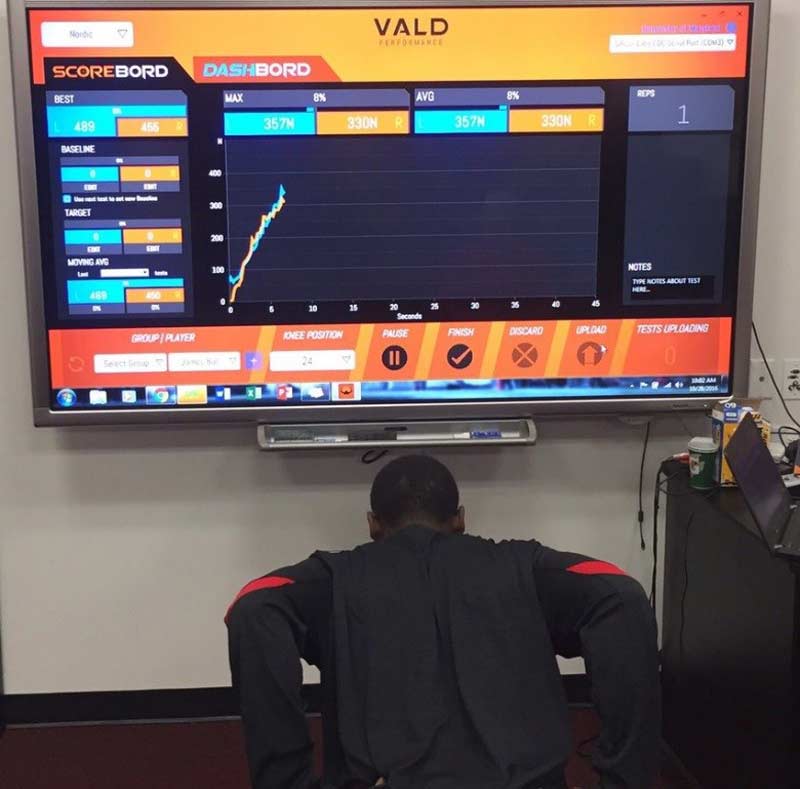
The Dashbord is a cloud-based data storage platform. You can access player data on the computer with the Vald Performance software installed, and also through a web browser on any other device. One of the key features of the Dashbord is the ability to compare athlete scores as text or in a simple bar graph. The most useful feature is the ability to export data in Excel or .csv formats.
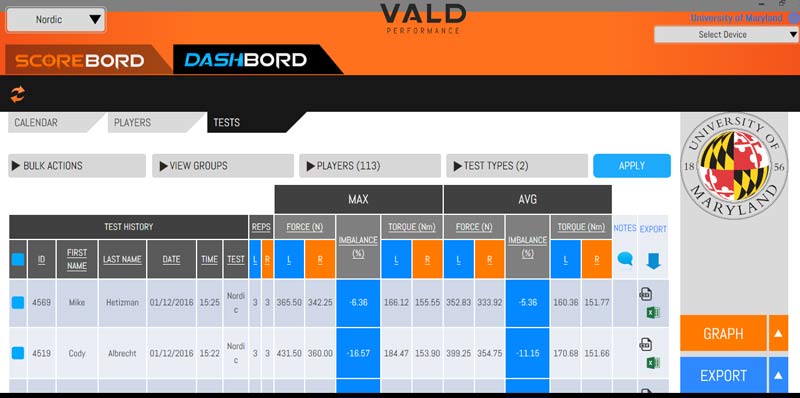
You can group tests by player, position, team, or test date, which makes for very easy data analysis on the back end. The exported data includes the raw scores for all of the tests selected, as well as other basic statistics for the selected population such as average, first quartile, and standard deviation for all tests included. All of this data can be exported in bar graphs and line graphs that show the force-time relationship of each rep. This all makes for even easier analysis and data visualization.
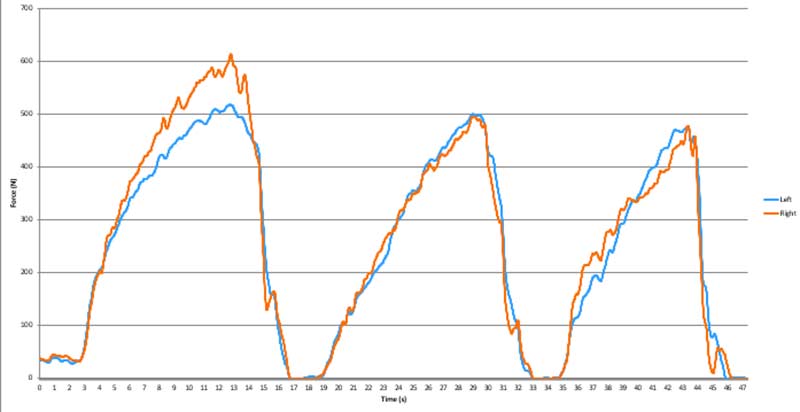
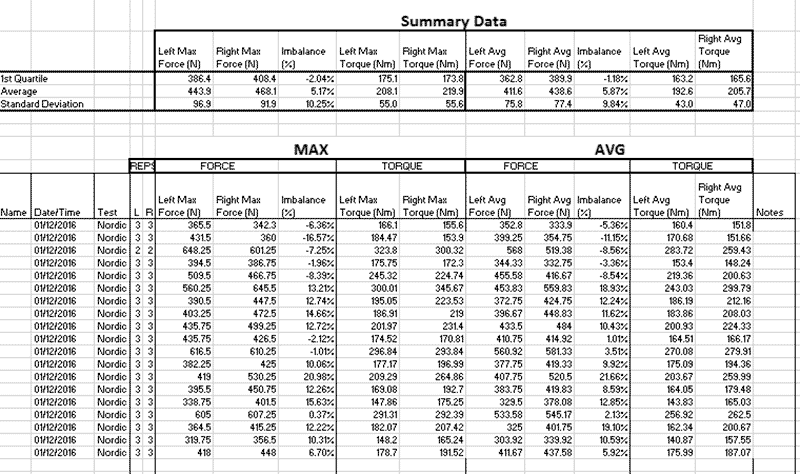
The Metrics Gathered by the NordBord
The vast majority of the research on hamstring strength as it relates to hamstring injuries (HSIs) done by the NordBord research group (Shields, Opar, Timmins, etc.) focuses on eccentric strength displayed during a Nordic Hamstring Curl. Therefore, it seems that the peak and average forces an athlete is able to produce during three consecutive Nordic Curls is the most useful of the data measured by the NordBord (1, 2, 4).
After strength, the between limb strength asymmetry displayed by the athlete is a metric of secondary importance (1). However, the software allows for the practitioner to select between a number of different hamstring exercises, including the Razor Curl; a 30-degree, 60-degree, and prone isometric hold; and any custom protocols developed by the practitioner. Outside of peak and average forces produced, the software also provides peak and average toque.
Using the Data
Currently, we use the data to customize the volume, frequency, and mode of eccentric hamstring work that our athletes do. After an initial four-week block when every athlete does Nordic hamstring curls two times a week, we then test the athletes on the NordBord. It is worth noting that athletes tend to be very sore the following few days after testing on the NordBord, so an initial acclimation period where the athletes perform Nordic Curls regularly for a few weeks is advised. Our four-week acclimation block is as follows (each performed 2x/week):
- Week 1 – 2×3
- Week 2 – 3×3
- Week 3 – 3×4
- Week 4 – 3×5
After the initial acclimation block, we test all of our athletes on the NordBord using the three Nordic Curls protocol, and then make adjustments to their training based on the results.
Based on the current literature regarding eccentric hamstring strength and limb asymmetry, we look for our athletes to be able to produce >340 N of force in both limbs, with a between limb strength asymmetry of <15% (1,2). After testing, we put the athletes in one of three interventions based on their results.
Intervention 1 is for athletes who can produce >340 N of average force in both limbs and have a between limb asymmetry of <15%. These athletes will perform Razor curls (a more intense eccentric hamstring exercise) 1x/week. While these athletes can produce sufficient levels of force that statistically puts them at a reduced risk for injury (2), there is still value in having them continue to perform eccentric contractions on a regular basis to maintain the structural adaptations of increased hamstring fascicle length (4). Research suggests that these structural adaptations can dissipate in as few as four weeks following the cessation of eccentric hamstring training (4).
If the athlete displays an ability to produce >340 N of force in both limbs, but has a between limb strength discrepancy >15%, then they will perform band-assisted, unilateral Nordic Curls 1x/week. They will perform a greater amount of volume on the weaker leg (usually four sets compared to two) in order to try to bring up the strength levels of the weaker leg to that of the stronger one.
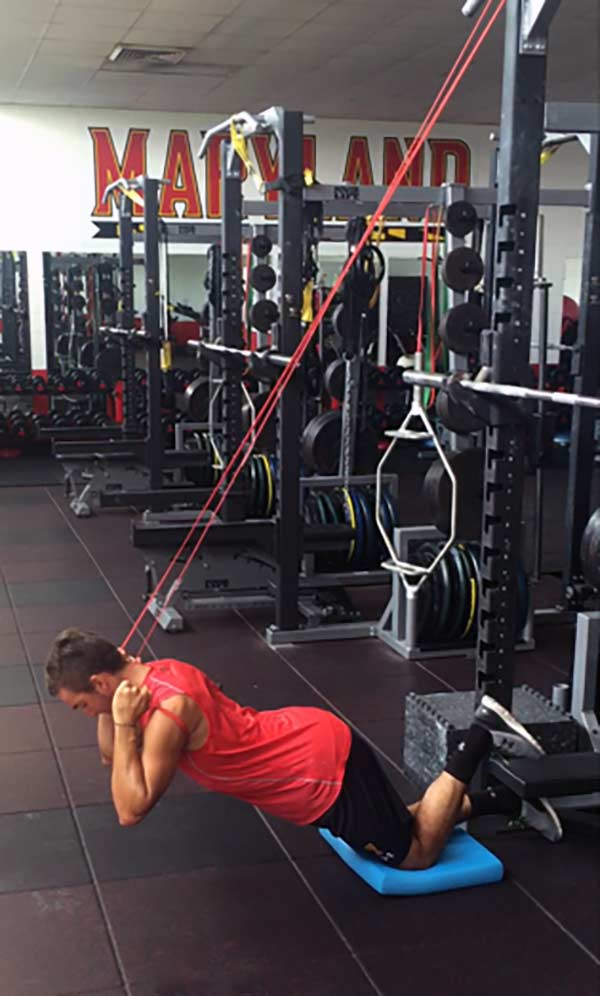
If the athlete is not able to produce >340 N of force in either limb, then they will continue with regular bilateral Nordic Curls 1x/week and band-assisted bilateral Nordic Curls 1x/week. The band allows for the athlete to get into a position of increased knee extension and work the more distal portion of the hamstrings in that position.
Outside of using the data as a means to measure strength progress, the data can also be useful for return to play (RTP) protocols for athletes that experience a HSI. We currently require the athlete to be at 90% of their pre-injury strength values before they are able to fully participate in practice. Other markers go into this decision as well, but the NordBord provides useful, objective strength measures that ultimately help the medical staff in making RTP decisions.
The NordBord’s Value
In my opinion, the NordBord is the best available tool to quickly and easily assess eccentric hamstring strength, but it is by no means inexpensive. While Vald Performance offers different pricing structures to different clients, you can expect to pay around $5,000/year for the hardware, software, and support. The support is top shelf, and includes access to some of the leading researchers in the world when it comes to training to reduce the risk of hamstring injuries. If you can afford it, I don’t think there is a better option on the market.
The NordBord is the best available tool to quickly and easily assess eccentric hamstring strength. Share on XHowever, the NordBord is still a luxury tool, and is by no means a necessity. Nordic Hamstring Curls work. If your athletes are compliant in terms of giving their best effort with the exercise, and the exercises are performed on a regular basis (minimum 1x/week), the athletes will get stronger. For example, our soccer players improved their eccentric hamstring strength by an average of 45 N in-season by performing Nordics only 1x/week (and never more than 15 total reps/session).
In the off-season, we have seen lacrosse players improve eccentric hamstring strength by more than 100 N in eight weeks by simply following the protocol outlined earlier in this article. However, the NordBord provides data that gives the practitioner objective feedback on exactly how strong the athletes are (which is useful for RTP protocols), as well as otherwise unobtainable more-nuanced information such as between limb strength discrepancies.
It’s the Best on the Market
If you are involved in a sport where HSIs are a primary concern (i.e., track athletes and most field-based sports), the NordBord provides objective, detailed, and actionable data to drive your programming. If you can afford the cost, there is nothing on the market better than the NordBord.
Since you’re here…
…we have a small favor to ask. More people are reading SimpliFaster than ever, and each week we bring you compelling content from coaches, sport scientists, and physiotherapists who are devoted to building better athletes. Please take a moment to share the articles on social media, engage the authors with questions and comments below, and link to articles when appropriate if you have a blog or participate on forums of related topics. — SF
[mashshare]
References
- Bourne M. N., D. A. Opar, M. D. Williams, et al. (2015). “Eccentric Knee-flexor Strength and Hamstring Injury Risk in Rugby Union: A prospective study.” Am J Sports Med, 43: 2663-70.
- Opar, D. A., M. D. Williams, R. G. TIimmins, J. Hickey, S. J. Duhig, and A. J. Shield. (2015). “Eccentric Hamstring Strength and Hamstring Injury Risk in Australian Footballers.” Med. Sci. Sports Exerc., 47(4): 857-865.
- Timmins, R. G., J. D. Ruddy, J. Presland, N. Maniar, A. J. Shield, M. D. Williams, and D. A. Opar. (2016). “Architectural Changes of the Biceps Femoris Long Head after Concentric or Eccentric Training.” Med. Sci. Sports Exerc., 48(3): 499-508.
- Timmins R. G., M.N. Bourne, A. J. Shield, M. D. Williams, C. Lorenzen, D. A. Opar. “Short Biceps Femoris Fascicles and Eccentric Knee Flexor Weakness Increase the Risk of Hamstring Injury in Elite Football (Soccer): A Prospective Cohort Study.” Br J Sports Med Published Online First: doi:10.1136/bjsports-2015-095362.




